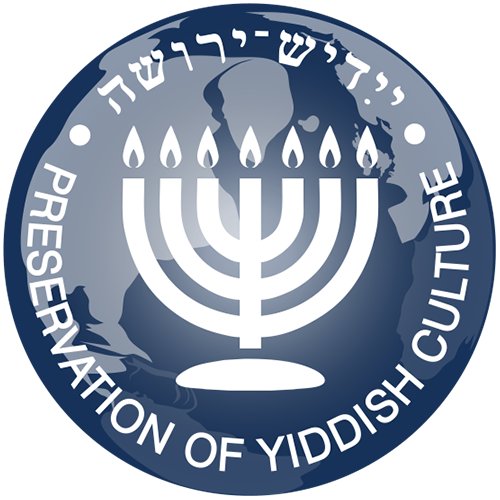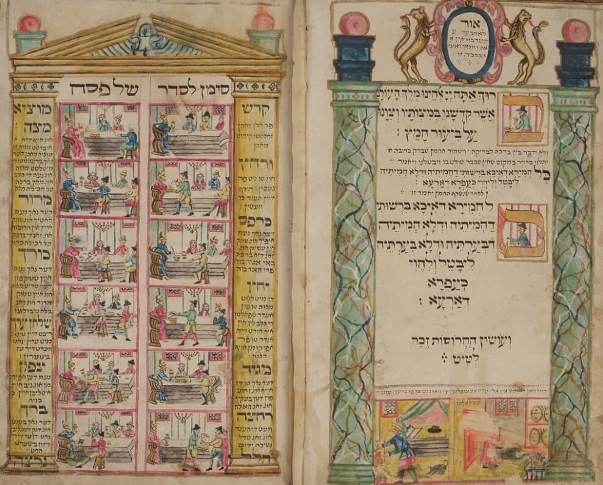Yiddish language
Yiddish is an Indo-European language belonging to the Germanic group. It emerged during the Middle Ages from an amalgam of Middle High German dialects. Today’s Yiddish speaker may be able to communicate relatively easy with those who speak Swabian, Bavarian and Austrian local dialects of German. The main obstacle of mutual understanding would be words of Semitic (Hebrew and Aramaic) and Slavic origin, abundant in Yiddish, but absent in any German dialect. The proportion of Semitic-based vocabulary in Yiddish dictionaries amounts to around 20%. This lexical layer is especially common when it comes to abstract concepts. Yiddish also contains unique remnants of some ancient Latinate substrate absent in German. Examples include such verbs as leyenen (to read) and bentshn (to bless). Such words indicate that the ancestors of the early language’s speakers were accustomed to some Romance dialect.
Illustrated Haggadah, Germany, 1756
The great Judaic authority Rabbi Shlomo Yitzchaki (1040-1105), generally known by the acronym Rashi, who lived in Northern France, often augments his Biblical and Talmudic commentaries written in Hebrew with vernacular terms, including a number of Germanic words. This testifies that some Jews who lived in today’s Western Germany already spoke some German dialect at that time. The oldest surviving literary document in Yiddish is a rhymed blessing found in a Worms Mahzor (holiday prayer book) from 1272.
As it is the case with other Jewish languages (a generic linguistic term used for often unrelated vernaculars spoken by various Jewish groups), Yiddish is written in Hebrew letters. Unlike the unvocalized writing systems of Hebrew and Aramaic, Yiddish writing is truly alphabetic. Certain Hebrew letters, sometimes with diacritic marks, are used as vowels. The only exception are the words of Semitic origin that retain their traditional unvocalized spelling. A few consonants absent in Semitic languages, such as “tch” and “zh”, are written using digraphs and trigraphs.
Yiddish literature arose in the Middle Ages. The most significant creations of this early literature are the anonymous paraphrased rendition of the biblical Book of Samuel (Shmuel-bukh) turned into an epic poem somewhat resembling the Nibelungenlied. Another highly influential epic-like masterpiece is Mayse-bukh, a collection of Jewish folk tales and legends. Elia Levita (1469-1549) composed the chivalric poem Bove-bukh, creatively derived from the Anglo-Norman romance of Bevis of Hampton. The extremely popular book Tsene-Rene by Rabbi Jacob Ashkenazi (1550-1624) gained the reputation of the “women’s Bible”.
An early form of Yiddish theater, associated with the holiday of Purim, emerged under the influence of the Italian folk theatre Commedia dell’arte. This theatrical genre of Purimshpil is characteristic of Ashkenazi Jews (Ashkenaz is the medieval Jewish name for Germany). The most popular plays would reenact, in a whimsical form, the events described in the biblical Book of Esther (Akhashveiresh-shpil) or the sale of Joseph by his brothers (Mkhires-Yoysef).
In the Late Middle Ages Ashkenazi Jews began to migrate towards the East. This wave of mass migration led to a wide geographical distribution of Yiddish far beyond Germany. By the 18th century, Yiddish was spoken by Jews from the Netherlands to Ukraine. Yiddish dialects became split into two distinct groups, Western and Eastern. During the first half of the 19th century, the Western group of Yiddish dialects gradually disappeared, being replaced by local non-Jewish languages, primarily German, which the Jews easily adopted due to its similarity to Yiddish. One exception was the Alsatian dialect, which almost died out by the end of the 20th century. At the same time, Eastern Yiddish, mainly spoken in the Slavic and Baltic countries, as well as Romania and Hungary, where the vast majority of Jews lived at that time, continued to flourish. Not only it retained its position, but it also became the basis of an extremely rich new national culture. During the second half of the 19th century, diverse eastern dialects of Yiddish, while still spoken colloquially, crystallized into a uniform literary language. A key role in this process was played by Mendele Moykher-Sforim (1836–1917) whom Sholem Aleichem (1859–1916) called “the grandfather of Yiddish literature”.
In the 1880s, the cultural and socio-linguistic ideology of Yiddishism began to take shape. Its main task was to elevate the status of Yiddish and to declare it the full-fledged national language, while relocating Hebrew to the background, as the language of religion not used in everyday life. Until that time, Hebrew, as a sacred and scholarly language, had immeasurably higher status than the commonly spoken vernacular. Yitskhok-Leybush Peretz (1852–1915) played an important role in the development of this ideology. Along with Mendele Moykher-Sforim and Sholem Aleichem, he is considered one of the three classics of modern Yiddish literature. Typologically, Yiddishism was quite similar to other national ideologies of various peoples in Central and Eastern Europe deprived of their own statehood, whose languages had a low social status, e.g. Czechs, Ukrainians, Lithuanians, Finns, etc. By the beginning of the 20th century, Yiddishism became widespread and featured by several Jewish political parties.
Yiddish enjoyed its most glorious heights during the interwar period. It was the native language of more than 10 million people both in Europe and in other countries that had sizable Jewish immigrant communities. Yiddish literature successfully mastered and further developed all styles and concepts of European modernism. Yiddish became a major language of the theater, cinema, press, school education, business and professional organizations. The Yiddish Scientific Institute (YIVO) was established in 1925 with branches in Vilna, New York, Berlin and Warsaw. During this period, Yiddish was also used to a limited extent in official governmental environments, primarily in the Jewish territorial autonomies created by the USSR.
The Holocaust caused the brutal destruction of the majority of Yiddish speakers in the traditional geographic areas where the language had been flourishing for centuries. Another major tragedy was the linguistic assimilation of most Yiddish-speaking immigrant families in the countries untouched by the Nazi genocide. Discriminatory laws against Yiddish were introduced, for different reasons, in the USSR and in the State of Israel, which severely hindered the transmission of this language to the younger generations. Yiddish was rapidly losing ground. During the second half of the 20th century, as the older speakers passed away, the number of native speakers kept sharply dwindling. Currently, the natural transmission of the language to children occurs almost exclusively in close-knit Ultra-Orthodox religious Jewish communities, primarily Hasidic. Unfortunately, their ideological attitudes tend to be at odds with the secular Yiddish culture and all its riches.
At the same time, the extremely rich Yiddish culture developed over the centuries, especially in the 19th-20th centuries, continues to attract a great interest of both Jews and non-Jews alike. Quite a few people study this language in academic institutions or on their own. There are also a few enthusiasts who do not belong to the Ultra-Orthodox camp and yet raise their children speaking Yiddish. The total number of active Yiddish speakers who use the language on a daily basis can now be estimated to about a quarter of a million people.

